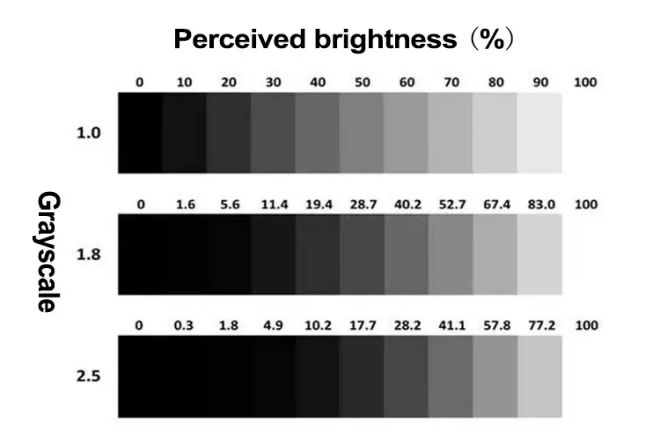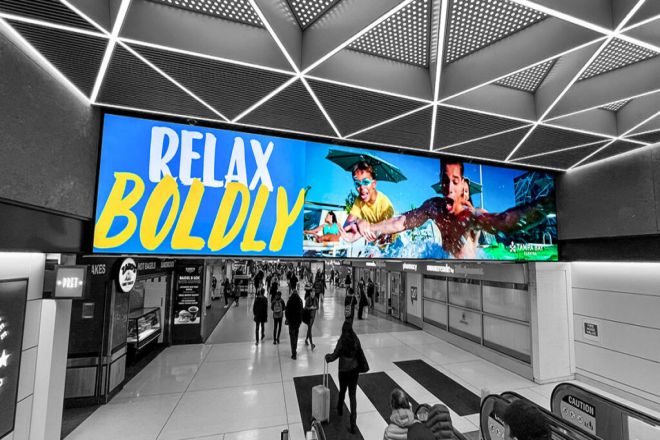مقدمة

شاشات عرض LED وقد تم استخدامها على نطاق واسع في مختلف المجالات، من الإعلانات التجارية والعروض المسرحية إلى شاشات المراقبة، وهي موجودة في كل مكان.
باعتبارها واحدة من المؤشرات الفنية الأساسية لشاشات LED، تلعب تقنية التدرج الرمادي دورًا حيويًا في تحسين تأثيرات العرض وإثراء مستويات الألوان.
هل تعرف تقنية التدرج الرمادي لشاشات LED؟ لا يهم إن لم تكن تمتلكها. ستأخذك هذه المقالة إلى دراسة التدرج الرمادي لشاشات LED.
1. مقدمة لمفهوم التدرج الرمادي لشاشة LED

يُعدّ تدرج الرمادي في شاشات LED مفهومًا مهمًا يتعلق بجودة عرض الصور، فهو مرتبط بسطوع الصور التي نراها وأدائها اللوني. ببساطة، يُعرّف تدرج الرمادي بأنه عدد مستويات السطوع على الشاشة من الأغمق إلى الأكثر سطوعًا.
كلما زاد عدد هذه المستويات، كلما كانت التغييرات الدقيقة التي يمكن أن تظهر في الصورة أكبر، مثل الانتقال من الأبيض والأسود إلى اللون وتصبح أكثر ثراءً تدريجيًا.
تخيل أنه عند النظر إلى لوحة فنية، إذا كان بها لونان فقط، الأسود والأبيض، ستبدو الصورة بسيطة للغاية وتفتقر إلى التسلسل الهرمي. أما إذا انتقلت الألوان في الصورة تدريجيًا من الأسود إلى الرمادي، ثم إلى الأبيض، فستكون طبقات الصورة أكثر ثراءً وتفاصيلها أوضح. هذا هو دور تدرج الرمادي في عرض الصور.
في شاشات LED، يُمكن لكل بكسل إصدار ضوء، ويُحدد التدرج الرمادي مدى سطوع هذه البكسلات. وكما هو الحال مع ضبط سطوع التلفزيون، كلما ارتفع التدرج الرمادي، زادت مستويات السطوع التي يُمكن للبكسلات عرضها، وأصبحت الصورة أكثر دقة.
ليس هذا فحسب، بل يرتبط تدرج الرمادي ارتباطًا وثيقًا بأداء الألوان. اللون مزيج من ثلاثة ألوان أساسية: الأحمر والأخضر والأزرق، بسطوع متفاوت. إذا لم يكن مستوى الرمادي كافيًا، فستكون تغيرات سطوع هذه الألوان الأساسية محدودة، مما يؤثر على ثراء الألوان وواقعيتها.
لتحقيق هذه التغييرات في مستوى الرمادي، يجب الاعتماد على نظام التحكم في شاشة LED. تحقق هذه الأنظمة قيمًا مختلفة لدرجات الرمادي من خلال التحكم الدقيق في سطوع ولون كل بكسل. بهذه الطريقة، يمكننا رؤية تلك الصور بألوان زاهية وتفاصيل غنية.
2. تدرج الرمادي لشاشة LED

يعد مستوى اللون الرمادي لشاشة LED أحد المؤشرات الرئيسية لتقييم جودة عرض الصورة.
يُمثل هذا المؤشر عدد مستويات السطوع التي يُمكن للشاشة تمييزها من الأغمق إلى الأفتح. كلما ارتفع مستوى الرمادي، زادت دقة تغييرات السطوع التي يُمكن للشاشة عرضها، وازدادت مستويات الألوان ثراءً، ووضوح تفاصيل الصورة.
يتم تحقيق تمييز مستويات الرمادي بشكل رئيسي من خلال دقة التحكم في سطوع البكسلات عبر نظام التحكم الداخلي لشاشة العرض. يتحكم نظام التحكم في سطوع كل بكسل من خلال ضبط تياره أو جهده بدقة لتحقيق مستويات رمادية مختلفة.
عادةً ما يكون هذا التحكم رقميًا، لذا يرتبط تدرج الرمادي ارتباطًا مباشرًا بعدد البتات. ومع التطور التكنولوجي المستمر، يُحسّن نظام التحكم باستمرار، مما يسمح لشاشة عرض LED بعرض تأثيرات صور أكثر دقة وواقعية.
يتم التعبير عن التدرج الرمادي عادة بوحدات "بت" لأن عدد مستويات التدرج الرمادي يتم حسابه بواسطة قوى 2.
على سبيل المثال: يعني تدرج الرمادي 8 بت أن الشاشة تعرض 2 أس 8 أو 256 مستوى مختلفًا من تدرج الرمادي. هذا يعني أنه من الأغمق إلى الأفتح، يمكن تقسيم الشاشة إلى 256 مستوى سطوع موحد. وبالمثل، 10 بتات تعادل 1024 مستوى رمادي، و12 بت تعادل 4096 مستوى رمادي، وهكذا.
3. ما هو الفرق بين درجات الرمادي لشاشات LED الداخلية والخارجية؟

هناك بالفعل بعض الاختلافات في تدرج الرمادي بين شاشات LED الداخلية والخارجية. وتعود هذه الاختلافات أساسًا إلى اختلاف بيئات تطبيقها واحتياجاتها.
أولاً، تتطلب شاشات LED الداخلية تدرجات رمادية عالية نسبيًا. بفضل ثبات الإضاءة الداخلية، وقرب الجمهور من الشاشة، يمكن رؤية تفاصيل الصورة وتغيرات ألوانها بوضوح أكبر.
لتقديم تأثير صورة أكثر دقة وواقعية، غالبًا ما تستخدم شاشات LED الداخلية مستويات رمادية أعلى، مثل مستويات رمادية 10 بت أو حتى 12 بت. بهذه الطريقة، يمكن للشاشة عرض مستويات سطوع أعلى، مما يجعل الصورة أكثر ثراءً في الألوان ووضوحًا في التفاصيل.
في المقابلعلى الرغم من أن متطلبات شاشات LED الخارجية ذات التدرج الرمادي ليست بنفس أهمية شاشاتها الداخلية، إلا أن لها خصائصها الخاصة. يتغير الضوء المحيط الخارجي بشكل كبير، وقد يؤثر ضوء الشمس المباشر أو الظلال على تأثير الشاشة.
لذلك، تولي شاشات LED الخارجية اهتمامًا أكبر لأداء السطوع والتباين لضمان صورة واضحة في مختلف ظروف الإضاءة. على الرغم من أن مستوى التدرج الرمادي قد يكون منخفضًا نسبيًا، إلا أن شاشات LED الخارجية لا تزال بحاجة إلى ضمان مستوى معين من التدرج الرمادي للحفاظ على تباين الألوان وإظهار التفاصيل في الإضاءة القوية.
فضلاً عن ذلك، تجدر الإشارة إلى أن أداء تدرج الرمادي في شاشات LED، سواءً كانت داخلية أو خارجية، يتأثر بنظام التحكم. ومن خلال تحسين نظام التحكم، يمكن تحسين إعادة إنتاج تدرج الرمادي والألوان في الشاشة، مما يُحسّن من جودة العرض بشكل عام.
لذلك، عند اختيار واستخدام شاشات LED، من الضروري تكوين مقياس الرمادي والتحكم فيه بشكل معقول وفقًا لبيئة التطبيق والاحتياجات الفعلية.
4. ماذا سيحدث لشاشة LED إذا كان إعداد تدرج الرمادي غير صحيح؟

إذا كان إعداد تدرج الرمادي لشاشة LED غير صحيح، فستحدث سلسلة من المشاكل الخطيرة، مما يؤثر بشكل كبير على جودة العرض وتجربة المستخدم. إليك شرح مفصل لما قد يحدث:
- فقدان تفاصيل الصورة وتشويه اللون
يُحدد تدرج الرمادي عدد مستويات السطوع التي يُمكن لشاشة LED عرضها. إذا كان إعداد تدرج الرمادي منخفضًا جدًا، ستنخفض مستويات سطوع الشاشة، مما يُؤدي إلى عدم القدرة على عرض تفاصيل الصورة بدقة.
على سبيل المثال، عند عرض منظر طبيعي، قد يضعف تأثير تدرج السماء والغيوم، وقد تصبح ملمس الأوراق والعشب غير واضح. في الوقت نفسه، يتأثر اللون بشدة.
بسبب نقص تدرج الرمادي، قد لا تستعيد الشاشة ألوان الصورة الأصلية بدقة، مما يؤدي إلى تشوه أو انحراف لوني. يُلاحظ هذا التشويه اللوني بشكل خاص عند عرض الوجوه أو القوام المعقدة، مما يجعل الصورة تبدو غير طبيعية أو مشوهة.
- انخفاض تباين الصورة ووضوحها
قد تؤثر إعدادات تدرج الرمادي غير الصحيحة أيضًا على تباين ووضوح شاشة LED. يشير التباين إلى الفرق في السطوع بين الأجزاء الأكثر سطوعًا والأكثر قتامة، وهو ما يحدد التباين بين الضوء والظلام في الصورة.
إذا كان إعداد تدرج الرمادي غير صحيح، فقد يؤدي ذلك إلى اختلال توازن التباين، مما يجعل الصورة تبدو ساطعة جدًا أو داكنة جدًا. سيؤثر هذا على إدراك الجمهور لمحتوى الشاشة ويقلل من تجربة المشاهدة. في الوقت نفسه، سيتأثر الوضوح. يشير الوضوح إلى حدة الصورة وتفاصيلها.
قد تؤدي إعدادات التدرج الرمادي الخاطئة إلى عدم وضوح حواف الصورة، مما يجعل من الصعب التمييز بين التفاصيل ويجعل الصورة العامة غير واضحة.
- هدر الطاقة وتقصير العمر الافتراضي
بالإضافة إلى تأثيرها على جودة العرض، قد تُسبب إعدادات تدرج الرمادي غير الصحيحة هدرًا في الطاقة وتُقصّر عمر الشاشة. فإذا كانت إعدادات تدرج الرمادي عالية جدًا، سيرتفع سطوع الشاشة بشكل كبير، مما يؤدي إلى زيادة استهلاك الطاقة. وهذا لا يزيد تكاليف التشغيل فحسب، بل قد يُشكّل أيضًا عبئًا غير ضروري على البيئة.
في الوقت نفسه، قد يُسرّع التشغيل طويل الأمد بسطوع عالٍ من شيخوخة الشاشة ويُقصّر عمرها الافتراضي. قد تتلف البكسلات بسبب السطوع الزائد، مما يُسبب مشاكل مثل ظهور بكسلات ميتة أو سطوع غير متساوٍ على الشاشة.
- انخفاض في تجربة الجمهور
بالنسبة للمشاهدين، ستؤدي شاشات LED ذات إعدادات التدرج الرمادي غير الصحيحة إلى تجربة مشاهدة سيئة. قد تُصعّب مشاكل مثل عدم وضوح الصور وتشوّه الألوان وضعف التباين على المشاهدين التركيز والاستمتاع الكامل بالمحتوى.
كما أن مشاهدة مثل هذا العرض لفترة طويلة قد يسبب أيضًا إرهاقًا أو إزعاجًا للعينين، مما يؤثر على تجربة المشاهدة.
خاتمة
هذه جميع المعلومات المتعلقة بتدرج الرمادي في شاشات LED. هل لديك الآن فهم محدد لتدرج الرمادي في شاشات LED؟ إذا كنت ترغب في معرفة المزيد عنها، الرجاء التواصل معنا!
